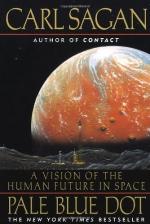
|
| Name: _________________________ | Period: ___________________ |
This quiz consists of 5 multiple choice and 5 short answer questions through Chapter 21, To The Sky!, Chapter 22, Tiptoeing Through the Milky Way.
Multiple Choice Questions
1. What does Sagan say is an easy way to visually identify planets?
(a) Their brightness.
(b) Their movements.
(c) The color of their atmospheres.
(d) Their size.
2. How much bigger is Neptune than Earth?
(a) A hundred times.
(b) Two hundred times.
(c) Four times.
(d) Forty times.
3. Earth will most likely lose contact with the Voyager probes when what happens?
(a) They pass the troposphere.
(b) They reach the Kuiper belt.
(c) Their solar cells die.
(d) Their radio transmitters die.
4. What characteristic of the atmosphere of Venus was initially impossible to explain?
(a) Its heat.
(b) Its dark spots.
(c) Its high winds.
(d) Its composition.
5. What was the state of the knowledge and belief about life on other planets at the time the book was written?
(a) Most believed life on other planets was impossible.
(b) It was believed there was abundant life on Mars.
(c) Scientists expected to find life on most of the planets and moons.
(d) No signs of life were known to exist.
Short Answer Questions
1. What is the primary distinguishing feature that SETI looks for to identify a communication from an intelligent source?
2. What is the most important thing that would immediately be apparent to any alien intelligence that found the Voyager probes?
3. What does Martian soil seem to contain?
4. CFCs are chemicals that is primarily hazardous to the environment in what area?
5. Sagan believes that Titan hosts oceans made of what compound?
|
This section contains 262 words (approx. 1 page at 300 words per page) |

|




